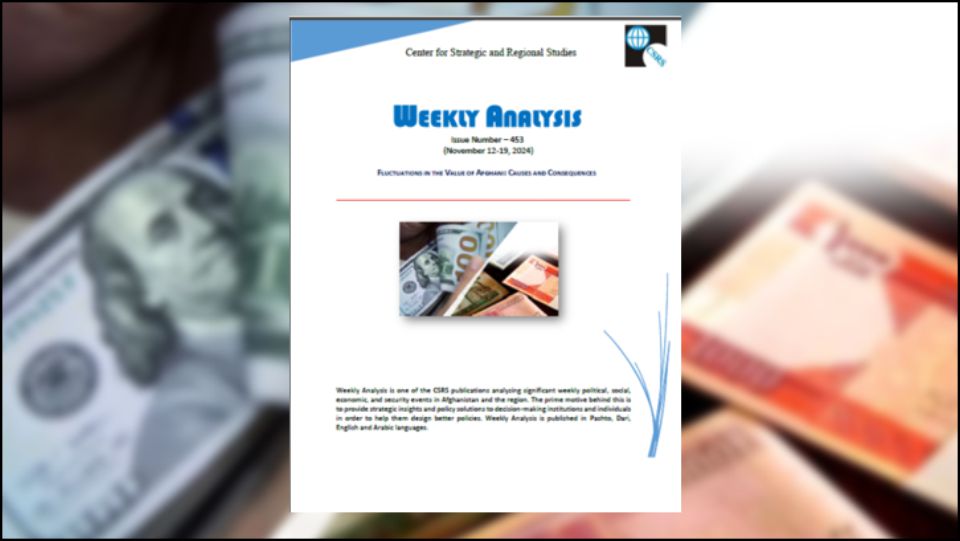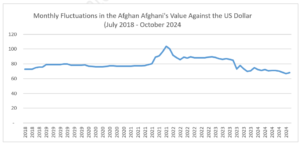By: Center for Strategic & Regional Studies
Note: Click here for the PDF file of this analysis.
___________________________________________________________________
In this issue:
-
- Fluctuations in the Value of Afghani: Causes and Consequences
- Causes of Fluctuations and the Increase in the Value of Afghani
- Impact of Fluctuations and the Increase in the Value of Afghani on Afghanistan’s Economy
- Conclusion & Recommendations
- Reference
- ______________________________________________
Introduction
Since the rise of the Islamic Emirate of Afghanistan to power, the value of the Afghani against foreign currencies, especially the US dollar, has significantly dropped. At one point, the exchange rate reached around 130 Afghanis per dollar. However, this situation didn’t last. Fast forward three years to October 2024, and the rate has settled at 65 Afghanis per dollar. Looking at the available statistics, it’s clear that since 2008, the Afghani has never really had a stable value and has always been fluctuating. Comparing the value of the Afghani against the dollar during the last three years of the previous government and the first three years of the Islamic Emirate of Afghanistan, we see that these fluctuations have taken different forms in each period. As the graph clearly shows, after the fall in Afghani’s value during the end of the Republic and the early days of the Islamic Emirate in 2021, Afghani has steadily increased in value against the dollar. However, the fluctuations have been more severe compared to the Republic era. In the past, the government had more monetary policy tools at its disposal, so the fluctuations were less intense compared to the current period under the Islamic Emirate. The most important of these tools included dollar auctions through Open Market Operations and the sale of Central Bank securities (Capital Notes). Currently, due to the freezing of Afghanistan’s central bank assets by the United States, dollar auctions are not possible, and the sale of securities has been halted due to religious reasons. The process of implementing Sukuk, which is seen as a suitable alternative, has not yet begun.
Causes of Fluctuations and the Increase in the Value of Afghani
The fluctuations and the increase in the value of the Afghani can be attributed to several factors. To understand this better, it’s important to have a basic grasp of the law of supply and demand. Simply put, if demand increases beyond the market equilibrium, prices go up, and if demand decreases, prices go down. Similarly, if supply increases beyond the market equilibrium, prices fall, and if supply decreases, prices rise. One of the reasons for the increase in the value of the Afghani is the reduced demand for foreign currencies. (According to the law of supply and demand, a decrease in the demand for dollars causes their price to fall.) This drop in demand has been a result of reduced imports and the outflow of foreign capital. With limited access to dollars and the impact of sanctions, there’s been a decline in the import of luxury and non-essential goods, leading to less need for dollars and a relative strengthening of the Afghani. Another key factor in the strengthening of the Afghani is the policies implemented by the Islamic Emirate to restrict the use of foreign currencies in domestic transactions. For instance, mandating the use of the Afghani for internal exchanges has reduced the demand for dollars in the domestic market, thereby supporting the Afghani’s value. Based on the law of supply and demand, these policies have increased the demand for Afghanis and, consequently, their value, while decreasing the demand for dollars and their value. The degree of dollarization in the Afghan economy has been quite high over the past two decades. People have relied on the dollar for both small and large transactions and savings due to its high credibility. Between 2008 and 2017, approximately 69% of all savings in Afghan commercial banks were in dollars. This indicates a strong preference among people to use dollars alongside Afghanis as a medium of exchange in the Afghan economy—one of the highest rates globally. Increased foreign currency earnings from exports are another factor contributing to the rise in the value of the Afghani. Analyzing Afghanistan’s export levels shows that in the past three years, exports have increased significantly, reaching $1.8 billion by the end of 2023. Naturally, Afghan traders receive foreign currencies, especially dollars, in exchange for their exported goods, and by converting these dollars to Afghanis, they increase the supply of dollars in the Afghan market, reducing their value against the Afghani. Another factor affecting the increase in the value of the Afghani is the reduction in the volume of Afghanis in economic circulation. This reduction can occur for various reasons. In the past, tools such as dollar auctions through Open Market Operations and the sale of securities were used to control money supply in the market, which are no longer implemented due to current conditions. Additionally, factors like the deterioration of Afghani banknotes and the prevention of neighboring countries’ currencies circulating in western, southern, and eastern regions have also decreased the supply of Afghanis in the market, thus increasing their value, a trend observed in the first two years of the Islamic Emirate’s rule. Lastly, we must not overlook the role of currency mafias and the psychological impacts that occasionally influence Afghanistan’s financial markets. These groups and individuals use their networks to spread fake news and manipulate exchange rates, sometimes limiting the supply of dollars to the market for personal gain, attempting to profit once the market rates reach their desired level. During the Republic era, the Central Bank used tools like Open Market Operations and securities sales to manage exchange rates, striving to maintain the value of the Afghani against the dollar and other foreign currencies with minimal fluctuations. However, due to restrictions and the halt of these tools, the Central Bank’s ability to directly control the Afghani’s value is significantly limited. As a result, fluctuations in the value of the Afghani have been more pronounced over the past three years.
Impact of Fluctuations and the Increase in the Value of Afghani on Afghanistan’s Economy
The fluctuations and the increasing value of the Afghani have had various effects on Afghanistan’s economy and society. Here are the key consequences:
- Impact on Inflation and Prices: Generally, an increase in the value of Afghani can help reduce the relative prices of imported goods, thereby controlling inflation. Many people prefer a strong Afghani to lower market prices. However, if the prices of imported goods do not drop with the rise in the Afghani’s value, the increase is merely nominal and doesn’t translate into real purchasing power. This is particularly true for Afghanistan. It’s important to note that a stronger Afghani does not affect the prices of imported goods that have increased globally. This increase in prices, known as imported inflation, stems from rising costs in the country of origin and is beyond the control of the importing country.
- Negative Impact on Employment and Economic Growth: While a stronger Afghani can lower the prices of imported goods to some extent, it can also increase the prices of domestically produced goods (following the law of supply and demand: higher prices lead to lower demand). Therefore, from an economic standpoint, the value of the Afghani should neither be too strong nor too weak against the dollar. It should be maintained at a reasonable level considering other major economic factors such as exports, economic growth, and inflation, and significant fluctuations should be avoided. Because of large fluctuations and the indirect relationship between the national currency’s value and price levels (as Afghani’s value increases, prices generally decrease and vice versa), investors struggle to accurately assess their profits and losses and make informed decisions. Moreover, despite the lower prices due to a stronger Afghani, buyers find it challenging to plan and execute their purchases properly. Consequently, fluctuations in the value of the Afghani can negatively impact employment and economic growth by reducing investment and demand.
- Reduced Competitive Power of Exports: An increase in the value of the Afghani can reduce the competitiveness of Afghan goods in international markets. When the Afghani strengthens, the final prices of Afghanistan’s export goods rise compared to similar foreign products, potentially leading to a decrease in export revenues.
- Relative Stabilization of the Domestic Economy: The increase in the value of Afghani, especially after a period of severe fluctuations, has provided relative stability to Afghanistan’s domestic economy. With reduced fluctuations and relative stability in the Afghani’s value, people are more likely to trust the Afghani over the dollar, which can help build confidence in the national currency. This can accelerate the process of de-dollarization and reduce the use of other foreign currencies. Ultimately, this strengthens national sovereignty and enhances the effectiveness of the government’s monetary and fiscal policies.
Conclusion and Recommendations
The fluctuations and increase in the value of the Afghani, driven by restrictive policies and reduced demand for foreign currencies, have had various impacts on Afghanistan’s economy. To improve the situation and achieve greater economic stability, the following recommendations are proposed:
- Setting Exchange Rate and Inflation Targets: Like other countries, to effectively control the exchange rate of Afghani against the dollar and manage inflation, the government should use economic models and in-depth analyses to set annual targets for the exchange rate and inflation percentage. These targets should ensure economic efficiency and maintain the key economic indicators in favorable conditions. Throughout the year, the government should use financial and monetary policy tools to keep the exchange rate and inflation levels close to the set targets. Given the current economic conditions and key indicators, an exchange rate of 70 to 75 Afghanis per dollar and an inflation rate of around 3% is recommended for Afghanistan’s economy.
- Implementing Comprehensive Monetary Policies and Using Sharia-Compliant Alternatives: Besides the existing monetary policy tools, such as dollar auctions within the Open Market Operations framework, the government should also use new monetary policy tools like Sukuk to manage liquidity and exchange rates. By buying and selling these tools in the market, it can prevent severe fluctuations in the value of the Afghani. Developing Afghanistan’s stock and capital markets is essential for this approach to succeed.
- Strengthening Foreign Exchange Reserves through Import Substitution Policies, Export Promotion, and Increasing Remittances: Investing in export sectors and reducing dependence on imports can improve the country’s foreign exchange reserves and stabilize the Afghani’s value. Implementing import substitution policies and boosting exports, along with increasing dollar remittances from Afghans living abroad, will strengthen the central bank’s reserves. The central bank can use these reserves as a monetary policy tool to control fluctuations in the Afghani’s value and manage inflation.
- Facilitating Foreign Investment: Providing necessary facilities and incentives for foreign investments can prevent capital outflow contribute to domestic economic stability and increase public trust. Besides factors like political stability, simple investment laws, and security, the less Afghani’s value and inflation rate fluctuate, the more foreign investors will be interested in investing in the country.
- Strengthening the National Currency: Promoting the use of Afghani in everyday transactions, encouraging savings in Afghanis, and preventing the circulation of neighboring countries’ currencies in Afghanistan’s markets can help strengthen Afghani and enhance its value and stability.
- Lifting Banking Restrictions: The Islamic Emirate should take more steps toward international recognition and work harder to lift banking restrictions, especially those on the country’s foreign reserves. These actions would significantly impact Afghani’s stability in both the short and long term, allowing the government to use reserves as a monetary policy tool to supply dollars in the market when necessary and control the amount of Afghanis in circulation.
References
- Tolo News LINK
- Exchange Rates, Da Afghanistan Bank LINK
- Exchange Rates, Moore Website LINK
- Exchange Rates, Investing Website LINK
- Afghanistan Exports LINK
- The Effects of Dollarization on Afghanistan’s Economy LINK
- The Impact of Inflation on Exchange Rates LINK


